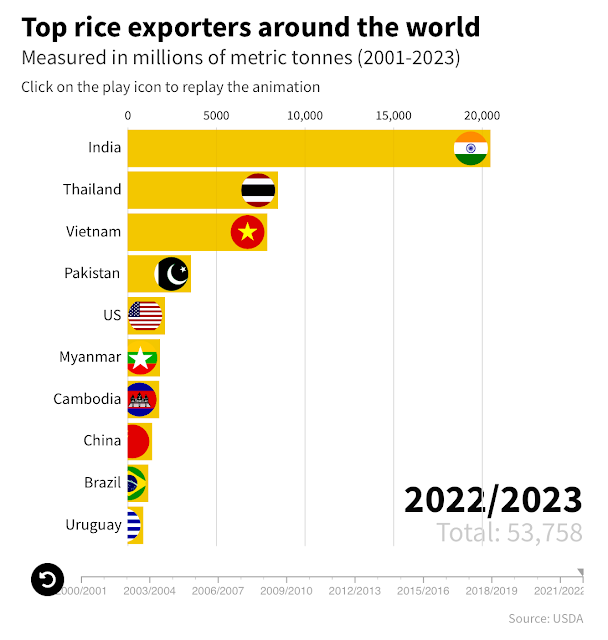Muslims are the poorest group in India. They will most likely face further marginalization after the recent inauguration of the Ram Temple built on the ruins of the historic Babri Masjid in Ayodhya. The medieval mosque was demolished by right-wing Hindu groups in 1992. While consolidating the power of the upper caste Hindus in India, the newly built Ram Temple, inaugurated by Indian Prime Minister Narendra Modi, will also not benefit the vast majority of Hindus either. It will, however, help Mr. Modi's BJP party win the upcoming election by a wide margin.
 |
| Average Monthly Per Capita Consumption Expenditure in India. Source: Hindustan Times |
Analysis of 2021-22 data from AIDIS (All India Debt and Investment Survey) and PLFS (Periodic Labor Force Survey) shows that Indian Muslims have the lowest asset and consumption levels among major religious groups in the country. Even upper caste Muslims (Ashrafs) are poorer than Hindu OBCs (Other Backward Castes).
Average MPCE (Monthly Per Capita Consumption Expenditure) for Muslims is only Rs. 2,170, lower than Rs. 2,470 for Hindus, Rs. 3,194 for Christians and Rs. 3,620 for Sikhs. Average MPCE for upper caste Hindus is Rs. 3,321, the highest of all groups.
 |
| Average Monthly Per Capita Consumption Expenditure by Caste in India. Source: Hindustan Times |
The economic inequality is the lowest among Muslims, far lower than among various Hindu castes. Average MPCE for lower caste Muslims is Rs. 2,164 while it is Rs. 2,180 for upper caste Muslims (Ashrafs). Inequality among Hindu castes is the highest. Lower caste Hindus average MPCE is only Rs. 2,095, far lower than Rs. 3,321 for upper caste Hindus.
India is almost totally dominated by the upper caste Hindus. It is not just the 220 million Dalits (untouchables), or the 190 million Muslims, or the 110 million from “scheduled tribes” (Adivasis) who are under-represented in positions of power and privilege, but also the 40-50% of Hindus who come from the widest tier of the pyramid, the shudras or laboring castes, known as Other Backwards Classes (OBCs), according to a report in The Economist Magazine. Here's an excerpt from The Economist:
"Out of the 89 highest-ranked civil servants in the central government, according to a recent survey, just four are not upper-caste Hindus, and not one is an obc. Two-thirds of the Supreme Court’s 31 judges and more than half of all state governors are high-caste Hindus. When the home ministry recently formed a panel to revise the criminal code, its five experts were all men, all from north India and all from upper castes. The trend is just as stark outside of government. A study published last year of the mainstream Hindi and English press revealed that out of 121 people in senior jobs, such as editors, all but 15 were upper caste. Not a single one was a Dalit."
------------------------------
PS: Since I published this post in January this year, there has been a barrage of comments (all rejected) claiming without evidence that the Indian Muslims are richer than Pakistani Muslims. The fact is that the average monthly per capita expenditure (MPCE) in Pakistan was PKR 5,959 in 2019-20, the year closest to the 2021-22 for which the Indian MPCE data is available. Using the 2019 average exchange rate of 2.136 PKR to INR, this works out to MPCE of INR 2,789 in Pakistan, higher than for Indian Hindus (INR 2,470) and Muslims (INR 2,170). As to the cost of living in the two countries, Pakistan is 15.8% cheaper than India without rent and 20.1% cheaper with rent, according to Numbeo.
Related Links:
Haq's Musings
South Asia Investor Review
South Asian Contrasts: Ayodhya and Kartarpur
India Ranked as Most Racist in the World
Indians Admire Israel and Hitler
Caste Apartheid in India
Mahatma Gandhi and His Struggle With India
Who Killed Karkare?
Procrastinating on Hindutva Terror
India's Guantanamos and Abu Ghraibs
Hindutva Government in Israeli Exile?
Growing US-India Military Ties Worry Pakistan
The 21st Century Challenges For Resurgent India
Riaz Haq's YouTube Channel
PakAlumni Social Network





